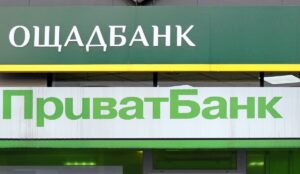
State-owned PrivatBank, Oschadbank and Ukreximbank have purchased the largest amount of domestic government bonds since the beginning of Russia’s full-scale invasion and have become market leaders in terms of government bonds with UAH 316 billion, UAH 154.2 billion and UAH 130.5 billion, respectively.
“PrivatBank’s clients mainly invest in hryvnia domestic government bonds (64.5%) and US dollar bonds (33.7%). At the same time, 80% of clients reinvest in securities of the Ministry of Finance when redeeming government bonds,” the financial institution’s press service said.
PrivatBank noted that every third hryvnia of the 1 trillion hryvnia raised in government bonds since the beginning of the full-scale invasion of Russia was invested by the bank or its clients.
In its turn, Oschadbank clarified that UAH 154.23 billion in equivalent of the total portfolio of domestic government bonds, UAH 26.6 billion, was purchased since the beginning of 2024, UAH 65.29 billion in 2023, and UAH 62.34 billion in 2022.
The top three are followed by the state-owned Ukrgasbank, which purchased the equivalent of UAH 89.3 billion of domestic government bonds in the primary market.
Among the top ten banks in the country in terms of assets, FUIB and Sens Bank also published data on investments in domestic government bonds.
Thus, according to the information on FUIB’s website, the amount of investments of more than 2 thousand clients of the bank (both individuals and legal entities) in government bonds since the beginning of the full-scale invasion has reached 1.6 billion in national currency, while foreign currency portfolios amounted to more than $50.5 million and EUR10.5 million, respectively.
The press service of Sens Bank indicates that as of today, the financial institution’s portfolio of government bonds held by individual investors is over UAH 8.1 billion, which “corresponds to about 13% of the total portfolio of government bonds held by individual investors in the country.”
“(…) our bank’s clients, both individuals and business representatives, continue to actively invest in securities. Thus, in April this year alone, our clients purchased government bonds worth UAH 1.87 billion, of which UAH 1.6 billion were military bonds,” the bank noted.
Sens emphasized that clients prefer hryvnia bonds, as the bank’s information shows that in April this year, 53% of consumers preferred them.
Other banks from the “Big Ten” by assets as of April 1 this year – Raiffeisen, Ukrsibbank, Universal Bank (mono) and Credit Agricole – did not publish information on the volume of purchases of government bonds since the beginning of February 24, 2022 on their websites at the time of the publication of this material.
At the same time, Kredobank, the 14th largest bank by assets, reported that its clients have invested more than UAH 3 billion in government bonds since the beginning of the full-scale Russian aggression, and more than 70% of this amount was invested in military bonds.
Kredobank reminded that it was one of the first banks to cancel brokerage fees for the purchase of military bonds after the war started and reduced the minimum investment amount in government securities to UAH 50 thousand.
“The main preferences of Kredobank’s customers for 2024 are short-term, up to 1 year, military government bonds in national and foreign currencies. We also observe that after the maturity of the bonds, more than 50% of customers re-invest their funds, doubling the amount,” said Serhii Kucheriavyi, Director of the Liquidity and Securities Department of the bank.
As reported, the Ministry of Finance managed to lower interest rates by another 0.1-0.27 percentage points (p.p.) at auctions for the placement of domestic government bonds on Tuesday, May 21, bringing the total decrease to 0.92-1.37 p.p. after the National Bank cut the discount rate from 14.5% to 13.5% per annum on April 26.
According to the website of the Ministry of Finance, the cut-off rate for one-year securities decreased from 15.15% to 15.05%, for two-year securities – from 16.2% to 16.08%, and for three-year securities – from 17.2% to 16.93%.